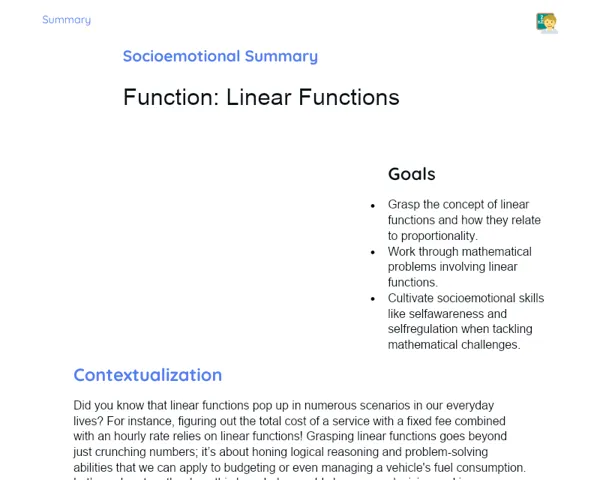Summary Tradisional | Determinants: Properties
Contextualization
Determinants are a core concept in linear algebra with plenty of real-world applications in mathematics and the sciences. They come in handy for solving systems of linear equations, checking if a matrix can be inverted, and even calculating volumes in analytic geometry. Grasping the properties of determinants can simplify many calculations, allowing us to solve problems more efficiently and accurately.
The relevance of determinants goes beyond theoretical maths, extending to fields like cryptography and engineering. For instance, techniques such as the Hill cipher rely on matrices and their determinants for encoding and decoding messages. In civil engineering, determinants are crucial for evaluating the stability of structures and tackling equilibrium force challenges. Thus, mastering the properties of determinants is vital for anyone keen on applying mathematical concepts to practical situations and addressing complex problems effectively.
To Remember!
Definition of Determinant
The determinant of a square matrix is a scalar value derived from the matrix's elements. This value is significant in linear algebra, particularly for resolving systems of linear equations and determining if a matrix is invertible. A matrix is deemed invertible only if its determinant isn’t zero. Additionally, the determinant plays a role in calculating volumes and areas in analytic geometry.
The formal definition of the determinant changes according to the matrix size. For 2x2 matrices, it’s found by multiplying the elements of the main diagonal and subtracting the product of the elements of the other diagonal. In larger matrices, it involves expansion by cofactors—a method that generates the determinant through a linear combination of the matrix’s minors.
The determinant also possesses specific algebraic properties that facilitate its calculation. These include linearity, effect of scalar multiplication, row or column swaps, and the existence of zeros in rows or columns. Understanding these properties is crucial for applying determinants effectively across various mathematical and scientific contexts.
-
The determinant is a scalar value linked to a square matrix.
-
A matrix can be inverted only if its determinant is non-zero.
-
The method of calculating the determinant differs with the size of the matrix, utilizing expansion by cofactors for larger matrices.
Property of Linearity
The linearity property of determinants states that adding multiples of one row or column to another doesn’t alter the determinant. In practice, this means that basic row operations, like adding a scaled version of one row to another, keep the determinant’s value intact. This property is particularly useful in simplifying matrices prior to calculating their determinants.
Grasping linearity is essential for adjusting matrices to ease the determinant calculation. For example, in solving linear systems, we can perform row operations to convert the augmented matrix into row echelon form without affecting the determinant of the original matrix. This helps us quickly ascertain if a matrix is singular (where the determinant is zero) or not.
The linearity property serves as a strong tool in linear algebra, enabling the simplification of challenging problems. By applying basic row or column operations, we can streamline the matrix for a more manageable format, making the determinant calculation less complicated and reducing the chance of mistakes.
-
Adding multiples of one row or column to another doesn’t change the determinant.
-
Elementary row operations can assist in calculating determinants more easily.
-
Linearity is helpful for solving linear systems and transforming matrices into simpler forms.
Property of Swapping Rows or Columns
The property regarding row or column swapping states that interchanging two rows or two columns flips the sign of the determinant. For instance, if the determinant of the initial matrix is D, after swapping two rows or columns, the new determinant will be -D. This property hinges on the arrangement of the rows and columns, closely tied to the geometry of the determinant.
This feature is especially handy when rearranging matrices to aid the determinant calculation. For example, while using Gaussian elimination, we may swap rows to place zeros below the main diagonal, thus streamlining the matrix and facilitating a straightforward determinant calculation.
Also, the swapping property sheds light on the algebraic structure of matrices. It illustrates that the determinant is a function of not just the matrix elements themselves, but also their arrangement order, highlighting the significance of careful matrix manipulation in algebraic calculations.
-
Swapping two rows or columns of a matrix inverts the sign of the determinant.
-
This property helps in rearranging matrices and simplifying determinant calculations.
-
Swapping rows or columns shows how the determinant depends on the order of the matrix elements.
Property of Zero Row or Column
If a matrix contains a row or a column made entirely of zeros, the determinant of that matrix equals zero. This property greatly simplifies the determinant calculation since the presence of a zero row or column negates the need for more intricate operations.
The rationale behind this property stems from the definition of the determinant as a sum of products; if a row or column's elements are all zeros, all related products will be zero, leading to a determinant value of zero.
This feature proves useful in many practical scenarios, like solving linear systems. If a matrix from a linear system has a row or column of zeros, we can quickly deduce that the system lacks unique solutions, meaning the matrix is singular. Hence, pinpointing zero rows or columns becomes an essential step in matrix analysis.
-
A matrix with a row or column of zeros will have a determinant of zero.
-
This property streamlines the determinant calculation by negating complex operations.
-
It's beneficial when analysing linear systems, indicating singular matrices.
Key Terms
-
Determinant: A scalar value related to a square matrix, vital for solving linear systems and calculating volumes.
-
Linearity Property: Adding multiples of one row or column to another does not affect the determinant.
-
Row or Column Swap Property: Swapping rows or columns changes the sign of the determinant.
-
Zero Row or Column Property: A row or column of zeros results in a determinant value of zero.
-
Cofactor Expansion: A technique for calculating the determinant using the matrix's minors.
Important Conclusions
During today’s lesson, we explored the crucial properties of determinants and their significance in linear algebra and real-world applications. We learned that the determinant represents a scalar value linked to a square matrix, possessing various properties that assist in calculation, including linearity, row and column swaps, and the presence of zero rows or columns.
We discussed the linearity property, which allows us to add multiples of a row or column without impacting the determinant, and the row or column swap property, which flips the sign of the determinant upon swapping. We also noted how identifying a row or column of zeros immediately indicates that the determinant of the matrix is zero, significantly easing calculations.
These principles are essential not only for theoretical mathematics but also for fields such as cryptography and civil engineering. Understanding and applying the properties of determinants empowers us to tackle complex problems more efficiently and accurately. I encourage you all to keep delving into this topic to enhance your understanding further.
Study Tips
-
Practice calculating determinants with various properties to deepen your understanding. Tackle exercises involving linearity, row/column swaps, and zero row/column identification.
-
Review class examples and try working through them independently, verifying if you can correctly apply the properties we discussed.
-
Explore additional resources and educational videos on determinants. Different teaching styles or explanations can often solidify your grasp of the concepts.



